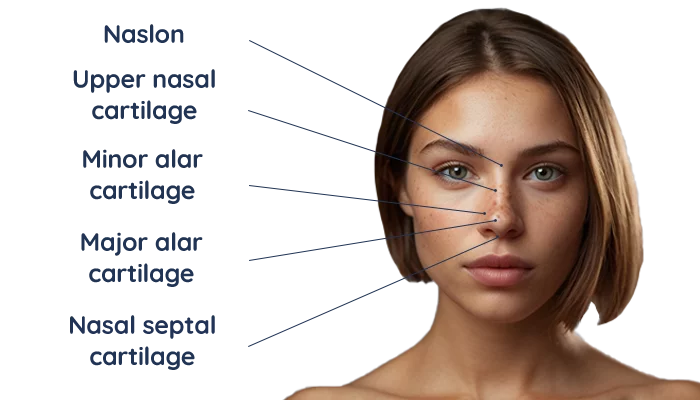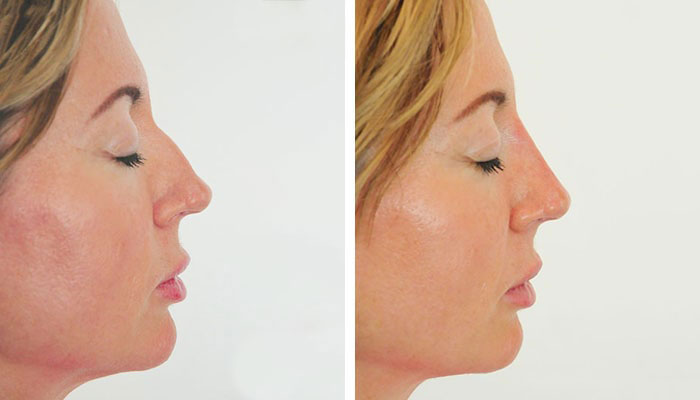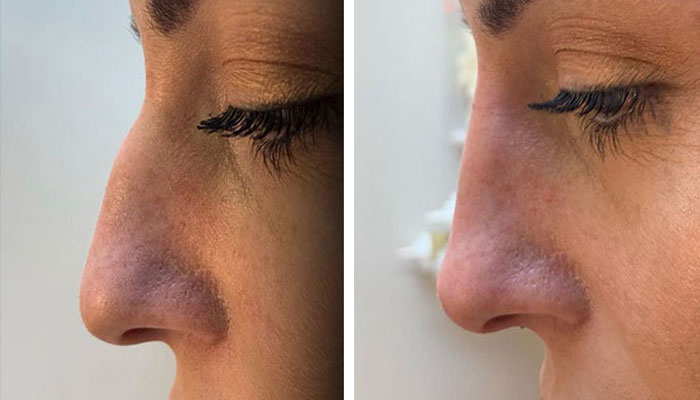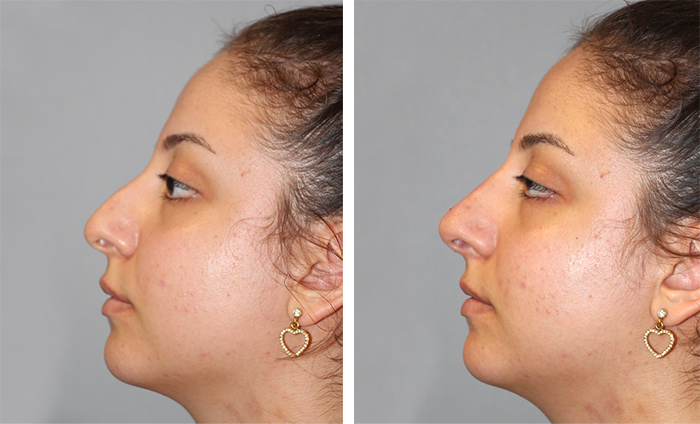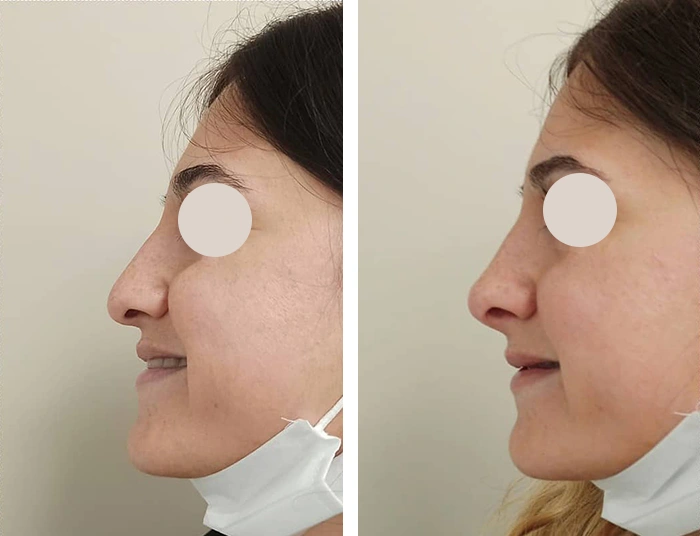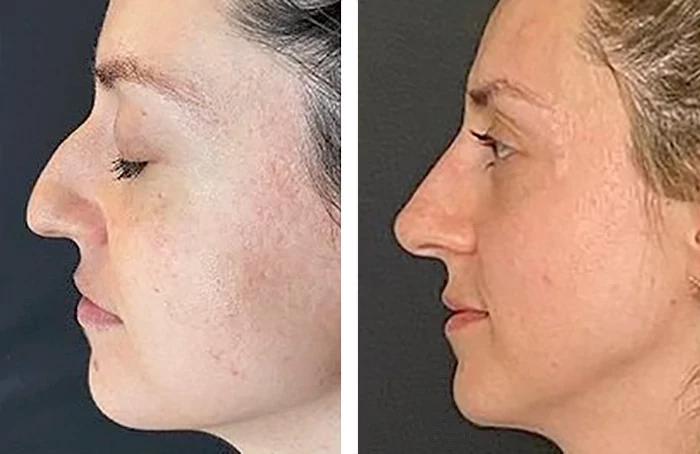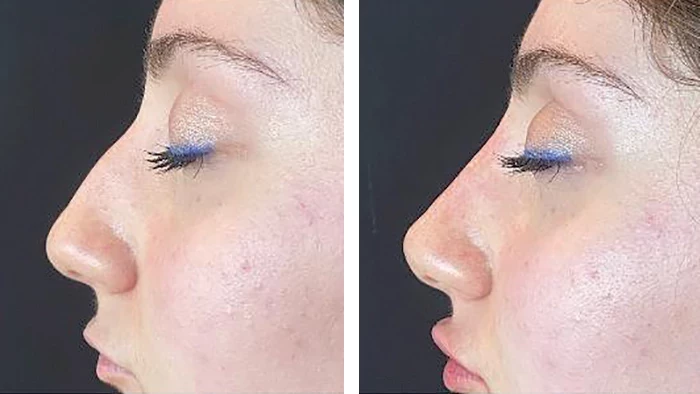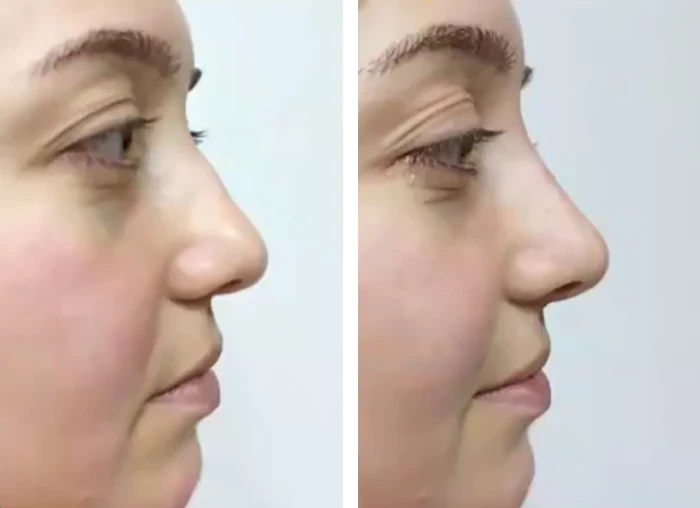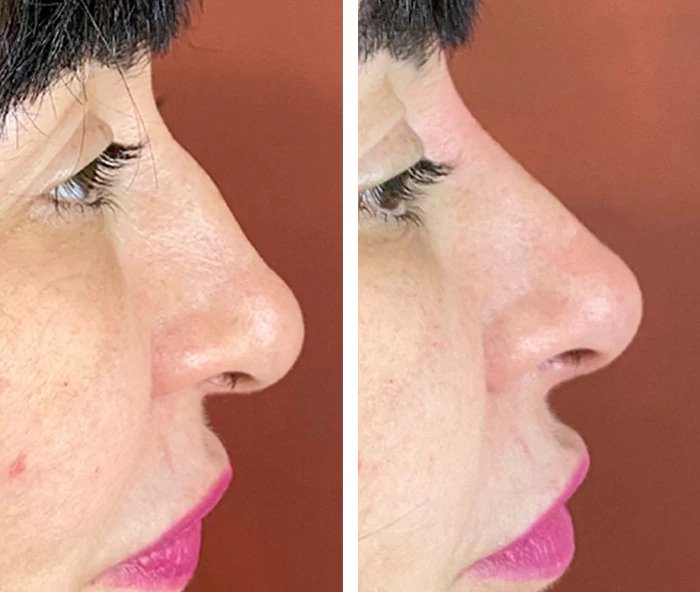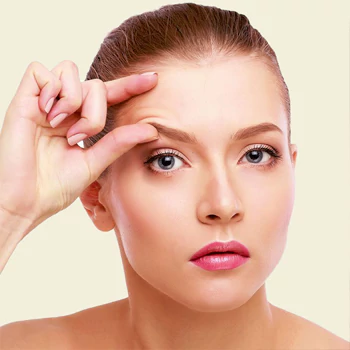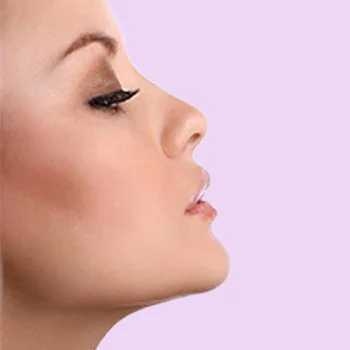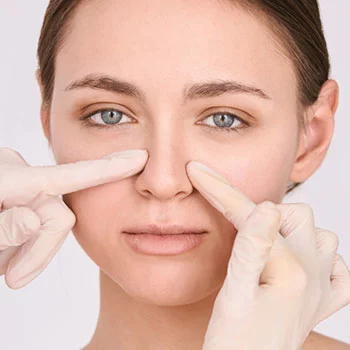What is nose filler?
Nose filler, also known as non-surgical rhinoplasty or liquid nose job, is a cutting-edge cosmetic procedure that utilizes dermal fillers to temporarily transform the shape of the nose and enhance facial harmony. Unlike traditional surgical rhinoplasty, this minimally invasive treatment offers a quick and affordable alternative for individuals seeking to improve the appearance of their nose without the need for anesthesia or extended downtime.
Dermal fillers, typically composed of hyaluronic acid (HA), are carefully injected into strategic areas of the nose to achieve desired results. HA fillers are highly effective and safe, as they naturally dissolve over time, providing temporary yet noticeable improvements in the nose’s definition, symmetry, and overall balance. Popular brands such as Revolax, Juvederm, and Restylane are often utilized for non-surgical nose jobs, offering versatility and extensive research-backed formulations.
One of the key advantages of nose filler is its flexibility. Patients have the ability to actively participate in the treatment process, providing feedback and observing the results unfold in real time. This interactive approach ensures that the final outcome aligns with their preferences and desired aesthetic goals. Additionally, the procedure is relatively quick, with immediate results that can be appreciated instantly.
What can nose filler do?
Nose filler, or non-surgical rhinoplasty, offers a range of possibilities for enhancing the appearance of the nose and achieving desired aesthetic goals. This innovative procedure can address various concerns and imperfections, providing individuals with a newfound sense of confidence and facial harmony. Here are some of the key transformations that nose filler can accomplish:
- Reshape the Nose: Nose filler can effectively alter the shape of the nose, addressing concerns such as a dorsal hump (bump on the bridge), a drooping or downturned tip, or an asymmetrical appearance. The contours of the nose can be refined, resulting in a more balanced and proportionate facial profile.
- Smooth Out Irregularities: If there are minor irregularities or indentations on the nasal bridge, nose filler can help smooth them out, creating a more even and streamlined contour. This is particularly beneficial for individuals who desire a straighter or smoother appearance.
- Lift the Nasal Tip: A drooping or sagging nasal tip can give the nose a tired or aged look. Nose filler can be used to lift and reshape the tip, providing a subtle yet impactful enhancement.
- Correct Nasal Imbalances: Nose filler can address asymmetry or imbalances in the nose, such as uneven nostrils or a deviated septum, leading to a more harmonious facial appearance.
- Camouflage minor flaws: Dermal fillers can be used to camouflage minor flaws or imperfections on the nose, such as small depressions or indentations.
Consulting with a qualified and experienced medical professional is crucial to determine if nose filler is suitable for your specific concerns and goals. They will evaluate your nasal anatomy, discuss your expectations, and develop a personalized treatment plan to help you achieve the desired aesthetic improvements.
What cannot nose filler do?
While nose filler, or non-surgical rhinoplasty, offers numerous benefits and can address various cosmetic concerns, there are certain limitations to be aware of. It is important to have realistic expectations and understand what nose filler cannot achieve. Here are some aspects that nose filler cannot accomplish:
- Reduce the size of the nose: Nose filler cannot effectively decrease the overall size of the nose. If you are seeking a significant reduction in the size of your nose, surgical rhinoplasty is typically the recommended approach.
- Correct significant structural issues: Nose filler is unable to correct major structural issues of the nose, such as a severely deviated septum or significant breathing difficulties. These conditions often require surgical intervention to address the underlying structural abnormalities and restore proper nasal function.
- Permanently alter the nose: The results of nose filler are temporary. Over time, the body naturally breaks down and absorbs the filler substance, causing the effects to gradually diminish.
- Address complex nasal deformities: Certain complex nasal deformities, such as extensive trauma, severe congenital abnormalities, or significant scarring, may not be effectively addressed with nose filler alone.
- Substitute for surgical rhinoplasty: While nose filler can provide significant enhancements and improvements to the appearance of the nose, it is not a substitute for surgical rhinoplasty in all cases. Surgical rhinoplasty offers a more comprehensive and permanent solution, allowing for extensive modifications to the underlying nasal structures.
Who is a good candidate for nose filler?
A good candidate for nose filler, or non-surgical rhinoplasty, typically meets certain criteria that make them suitable for the procedure. While a consultation with a qualified medical professional is essential to determine individual candidacy, here are some general factors that may indicate someone is a good candidate for nose filler:
- Individuals with cosmetic concerns: Nose filler is ideal for individuals who have specific cosmetic concerns about the appearance of their nose.
- Individuals seeking non-surgical options: Candidates who prefer to avoid surgery, anesthesia, and the associated downtime may find non-surgical rhinoplasty an attractive option.
- Individuals with realistic expectations: While the procedure can achieve significant improvements, it has limitations and cannot achieve the same level of transformation as surgical rhinoplasty.
- Healthy individuals: Candidates for nose filler should not have any active infections or skin conditions in the treatment area.
- Non-Smokers: Smoking can affect the healing process and increase the risk of complications
- Those open to temporary results: Candidates should be comfortable with the idea of undergoing touch-up sessions to maintain the desired results or consider alternative options if they desire long-term or permanent changes to their nose.
How is nose filler procedure performed?
The nose filler procedure is typically performed in a clinical setting and involves the following steps:
- Preparing the treatment area: The treatment area, including the nose and surrounding skin, is thoroughly cleaned and prepped to ensure it is free from any dirt, oils, or makeup. This step helps minimize the risk of infection and ensures optimal conditions for the procedure.
- Numbing the area: To enhance comfort during the procedure, a topical numbing cream may be applied to the treatment area. This cream numbs the skin, reducing any potential discomfort or pain associated with the injections. In some cases, the filler itself may contain a local anesthetic to provide additional numbing effects.
- Marking injection points: The medical professional will assess your nasal anatomy and mark the specific injection points on your nose. These points are strategically chosen based on your desired outcomes and areas that require enhancement or correction.
- Injection of dermal filler: Using a fine-gauge needle or cannula, the medical professional will carefully inject the dermal filler into the predetermined injection points. The filler substance is introduced into the deeper layers of the skin and underlying tissues to achieve the desired shape and contour changes.
- Sculpting and molding: After the filler is injected, the medical professional will sculpt and mold the filler using their hands or specialized tools. This step allows them to precisely shape and refine the filler to achieve the desired results. The medical professional will assess the symmetry, balance, and overall appearance of the nose during this process.
- Assessing the results: Throughout the procedure, the medical professional will assess the progress and evaluate the results. They may ask for your feedback and input to ensure your satisfaction with the changes being made to your nose. Adjustments can be made as needed to achieve the desired outcome.
It is important to note that the specific techniques and tools used during the procedure may vary depending on the medical professional’s expertise and the type of dermal filler being used. Your medical professional will guide you through the process and provide personalized care to ensure optimal results and minimize any potential risks or complications.
How to prepare for nose filler?
To prepare for a nose filler procedure, it is important to have a thorough consultation with a qualified medical professional. During this consultation, the individual’s goals, medical history, and any potential allergies or sensitivities are discussed. It is recommended to avoid blood-thinning medications, alcohol, and strenuous exercise prior to the procedure. Following any pre-procedure instructions provided by the medical professional is also essential.
What is nose filler recovery like?
The recovery process after a nose filler procedure is generally minimal, and most individuals can resume their normal activities immediately. However, it is important to note that each person’s experience may vary slightly. Here is what you can generally expect during the nose filler recovery period:
- Swelling and bruising: Some swelling and bruising are common after a nose filler procedure. The degree of swelling and bruising can vary among individuals, but it is generally mild and subsides within a few days. Applying cold compresses to the treated area can help reduce swelling and alleviate any discomfort.
- Sensitivity and tenderness: The nose may feel slightly sensitive or tender after the procedure. This sensitivity is temporary and should resolve on its own within a few days.
- Avoiding pressure and trauma: It is important to avoid excessive pressure or trauma to the treated area during the initial recovery period. Avoid rubbing or massaging the nose and refrain from wearing glasses or sunglasses that put pressure on the nose for a few days.
- Makeup and skincare: You may be advised to avoid applying makeup or using certain skincare products on the treated area for a short period. This allows the filler to settle and reduces the risk of infection or irritation.
- Follow-up appointments: Your medical professional may schedule a follow-up appointment to evaluate the results and ensure that you are healing properly. During this appointment, any necessary adjustments or touch-ups can be discussed.
Nose filler risks and complications
While nose filler procedures are generally considered safe, there are some potential risks and complications associated with the treatment. It is important to have a thorough understanding of these risks and discuss them with your medical professional before undergoing the procedure. Some potential risks and complications of nose filler include:
- Infection: Although rare, there is a small risk of infection at the injection sites. It is crucial to ensure that the procedure is performed in a sterile environment by a qualified medical professional to minimize this risk.
- Allergic reactions: Although uncommon, but some individuals may be allergic to the components of the filler substance. It's important to inform your medical professional about any known allergies or sensitivities you have.
- Nodules or lumps: In some cases, small nodules or lumps may develop at the injection sites.
- Vascular complications: Although extremely rare, there is a risk of vascular complications during the procedure. If the filler is inadvertently injected into a blood vessel, it can cause blockage or compromise blood flow. This can potentially lead to skin necrosis (tissue death), scarring, or other serious complications.
- Asymmetry or overcorrection: There is a slight risk of asymmetry or overcorrection. This can result in an unnatural or imbalanced appearance.
- Migration or displacement: In some cases, the filler may migrate or shift from its original placement. This can occur due to factors such as excessive movement of the treated area or improper injection technique.
- Granuloma formation: Granulomas are small, localized inflammatory reactions that can occur in response to the filler material. They can present as bumps or nodules and may require additional treatment to address.
- Skin irregularities or texture changes: In rare cases, the filler may cause changes in the texture of the skin, resulting in lumps, bumps, or irregularities.
Note that while these risks and complications exist, they are generally rare when the procedure is performed by a qualified medical professional. To minimize these risks, it is crucial to choose a reputable practitioner who has extensive experience in performing nose filler procedures.
It is recommended to have a detailed discussion with your medical professional about the potential risks, complications, and any specific concerns related to your individual circumstances before deciding to undergo a nose filler procedure.
Nose filler cost
The cost of a nose filler procedure can vary depending on factors such as the geographic location, the expertise of the medical professional, the type of filler used, and the extent of treatment required.
Generally, nose filler procedures range from a few hundred to a few thousand dollars. It is important to consider the qualifications and experience of the medical professional in addition to the cost when making a decision.
It is important to note that the cost of the filler itself is typically calculated per syringe. The number of syringes required for the procedure depends on the individual’s goals, the desired results, and the evaluation of the medical professional. In some cases, multiple syringes may be needed to achieve the desired outcome.
It is worth noting that nose filler procedures are typically considered cosmetic treatments and are not covered by health insurance. However, some clinics may offer financing options to help make the procedure more affordable.
Nose filler results
Nose fillers can provide immediate results that are visible right after the procedure. They can improve the symmetry, shape, and proportions of the nose, resulting in a more balanced and refined appearance.
The duration of the results varies, typically lasting between 6 to 18 months. Regular touch-up sessions may be necessary to maintain the desired outcome over time.
It is important to have realistic expectations and communicate your goals clearly with your medical professional during the consultation. They will assess your nose's characteristics, discuss the potential outcomes, and provide guidance on what can be achieved with nose fillers based on your unique situation.
Remember, results can vary from person to person, and it is crucial to choose a qualified and experienced medical professional to ensure safe and satisfactory outcomes.
Frequently Asked Questions
What is a nose filler?
Nose filler, also known as non-surgical rhinoplasty or liquid rhinoplasty, is a cosmetic procedure where dermal fillers are injected into specific areas of the nose to improve its shape, symmetry, or proportions.
How long do nose fillers last?
The duration of nose filler results can vary depending on the type of filler used. On average, nose fillers typically last between 6 to 18 months. Regular touch-up sessions may be needed to maintain the desired results.
Is a nose filler procedure painful?
Most nose filler procedures involve the use of a topical anesthetic or a numbing agent to minimize discomfort. While some individuals may experience mild discomfort during the injection process, the procedure is generally well-tolerated.
Are nose fillers permanent?
No, nose fillers are not permanent. They provide temporary results as the filler substance gradually breaks down over time. The results last for about 6-18 months, after which the nose will return to its pre-treatment appearance.
Are nose fillers reversible?
In some cases, certain types of nose fillers can be partially or fully reversed using an enzyme called hyaluronidase. Hyaluronidase can dissolve the filler if necessary, providing a way to modify or remove the effects of the filler.
Can nose fillers correct all types of nasal issues?
Nose fillers are effective for addressing certain cosmetic concerns such as minor bumps, depressions, asymmetry, or drooping of the nasal tip. However, they cannot correct functional issues like breathing difficulties or septum deviations, which may require surgical intervention.
What are the potential risks and complications of nose fillers?
While nose fillers are generally safe, potential risks and complications include infection, allergic reactions, nodules or lumps, vascular complications, asymmetry, migration or displacement, granuloma formation, and skin irregularities. These risks can be minimized by choosing a qualified and experienced medical professional.
How long is the recovery period after a nose filler procedure?
The recovery period after a nose filler procedure is typically minimal. Most individuals can resume their normal activities immediately. However, some swelling, bruising, sensitivity, or tenderness may be present temporarily. These effects generally subside within a few days.
How much does a nose filler procedure cost?
The cost of a nose filler procedure can vary depending on factors such as the location, expertise of the medical professional, type of filler used, and the extent of treatment required. Generally, nose filler procedures range from a few hundred to a few thousand dollars.

